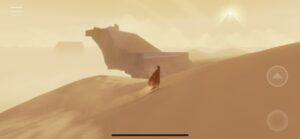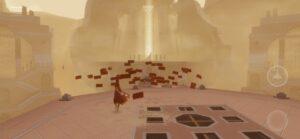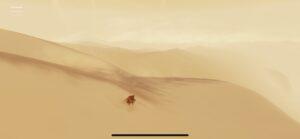This week, I played Journey, an indie adventure game. It was developed by Thatgamecompany, published by Sony Computer Entertainment and directed by Jenova Chen. I played the game on iOS, using my phone. Walking through the world creates the environmental narrative of Journey. It tells the story that you are not going about life alone, no matter how it may seem. There is a long lineage of others who are helping you along the way.

The game is set in a vast desert. You play as a robed figure with a red scarf. There is little in the distance except a mountain, which the player is attempting to reach. There are few actions the player can take but walk around. Besides this, the player is able to jump, which uses some of the “charge” on their scarf, and sing a musical note. In order to recharge their scarf, the player must stand near other pieces of floating red cloth, which resembles the cloth on the player’s scarf. When the player sings near larger pieces of dull red cloth, they glow and help the player progress through the game, either by creating a bridge, allowing the player to jump higher, or releasing more bits of other cloth.

Walking in the game is very beautiful. One of the types of fun I enjoyed while playing the game was sensation; the desert setting is peaceful and the musical score is a perfect accompaniment to the walking. The sound of the musical notes is in harmony with the score, so even when singing there is no sense of chaos, only peace. However, it also creates an eerie environment, since at the beginning I appeared to be completely alone in an expansive, infinite desert.
Through walking and exploration, an embedded narrative is created. The game leads the player through several levels, each closer and closer to the mountain. When I tried to walk in a direction that wasn’t towards the next level, the sand would blow the character towards the right path. The player discovers red scarf pieces flying around, which “recharge” the player’s jumping ability. The level architecture of the game created distinctions, namely that from level to level more scarves join the player and the player’s own scarf gets longer, representing the aid of other players and beings that came before.

There was also a game mechanic that I never discovered – other players can join you on your journey. Maybe because I was playing on iOS or because other players weren’t present, I didn’t know or witness this until afterwards, when I was reading about the game. This further emphasizes to the player that they are not alone – not only are there previous “scarves” or beings helping you through the world but there are literally other people making the same journey as you. The unknown is scary and vast, but with the help of others, life can be made easier.
Journey is a beautiful and moving game. It was the first walking simulator I played, and it proved to me how powerful even wordless games can be in telling a story through gameplay.


